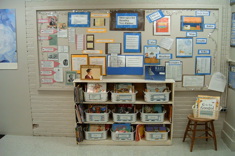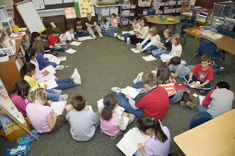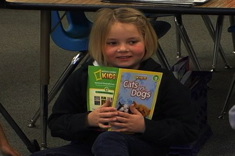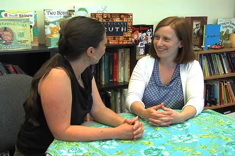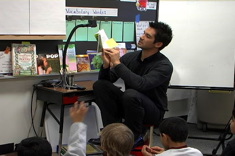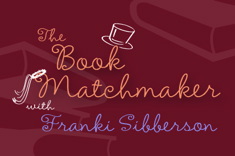What we often forget when considering the importance of nonfiction reading is the pleasure, the art, the wonder of it. We do not want to develop students who read nonfiction just for function, or for school success, but students who read nonfiction for enjoyment, to be fascinated, to discover.
Nell Duke
I realized years ago that my 4th and 5th grade students were not choosing nonfiction for their independent reading time. When we discussed this as a class, the kids were honest. They had found many great novels to enjoy and they were hooked. They didn't want to give up reading the fiction that they had come to love in order to read nonfiction. This made a lot of sense to me. When I think about my own reading, I make time for nonfiction reading, but it never gets in the way of my fiction reading. I set aside separate times for each.
I reflected on our conversation, and realized that although we did do a lot of nonfiction reading in class, almost all of it was in some way connected to content we were studying. Every so often I'd read aloud a book or an article just because it was a fun topic, or something would be in our weekly news magazine that was unrelated to our curriculum in science or social studies. But most often, I chose books that were connected in some way to our social studies or science content.
I looked through the large nonfiction library I had in the classroom. As I predicted, most of the books I had purchased over the years were somehow linked to science or social studies content. It was no wonder that my students saw nonfiction reading as "school reading." I knew I had to do something to hook this class on nonfiction.
Nonfiction Reading Time
I decided to start a "Nonfiction Reading Time" in the classroom. Each morning when the students arrived, I began the day with Nonfiction Reading Time instead of a more traditional morning assignment. For about 15-20 minutes each morning (except for Friday, which was Poetry Friday!) time was set aside for students to read nonfiction of their choice. Because we didn't often share our nonfiction reading with others as a class, I made time (two to three minutes each day) for informal sharing of great nonfiction facts and books that students wanted to share.
This routine was one of the simplest things I've implemented in my twenty years of teaching. The impact it had on students' reading lives was huge. Students became readers of nonfiction because I provided time and great nonfiction books. They quickly fell in love with nonfiction, and many began choosing nonfiction books for their reading workshop time. Their nonfiction reading skills improved because they were reading about topics of their choice. Nonfiction Reading Time has allowed my students to become independent readers of both fiction and nonfiction.
Because the routine was so successful, I've continued it over the past few years. Instead of a daily routine, two mornings a week are devoted to Nonfiction Reading Time. To keep the reading time interesting, I am always on the lookout for new nonfiction titles to add to our nonfiction library.
I look for books that are visually appealing, as well as books on topics that interest my students; I also look for books that can be read from cover to cover in a few sittings. I realized after observing my students that many of them were comfortable browsing nonfiction that was scattered across the page. Yet having books they could read cover to cover was important too. Here are some of our favorite nonfiction choices.
Nonfiction Books You Can Easily Read Cover to Cover
I have found that it is important for me to provide students in the upper elementary grades with nonfiction books that are written in a more narrative form. Many of these books are in a nonfiction narrative form that is comfortable for students to read. When students experience reading a book from cover to cover, they learn many new things and build new questions about a topic. I have been looking for good nonfiction narrative books that have great illustrations and/or photographs to support the reader.
The Journey That Saved Curious George by Louise Borden
The true story of Margaret and H.A. Rey's escape to the United States with a draft of the first Curious George manuscript in their bag.
Hey Batta Batta Swing! The Wild Old Days of Baseball by Sally Cook and James Charlton
A fun look at the history of baseball, this book shares many facts in a kid-friendly way. The illustrations are perfect for the subject.
You Forgot Your Skirt, Amelia Bloomer by Shana Corey
It is always surprising to our students that there was a time when girls were not allowed to wear pants. They love to read this simple picture book about Amelia Bloomer, who made "bloomers" popular. A great author's note provides additional information.
Hero Dogs: Courageous Canines in Action by Donna M. Jackson
The stories of several "hero dogs" are shared in this book. In narrative form, the author tells the stories of several working dogs that have made a huge impact in the world. The photos help make the information accessible to students.
Sneeze! by Alexander Siy
This book shares lots of information about sneezes, with a focus on the reasons people sneeze. The magnified photographs add interesting information and make this book visually appealing.
Nonfiction Books with Interesting Topics for Intermediate Students
Here are some of the books my students find most engaging, and they have few if any connections to the content area topics we explore each year.
Albino Animals by Kelly Milner Halls
This book presents information on many albino animals around the world. The photographs are intriguing and draw the reader in.
Dogs and Cats by Steve Jenkins
A great book for animal lovers, chock-full of information. The format and illustrations make it one of the best dog and cat books I've seen.
What Stinks? by Marilyn Singer
This book obviously focuses on things that stink. It is written with humor and packed with facts. The photos and illustrations are colorful and spread out across the pages.
Transformed: How Everyday Things Are Made by Bill Slavin
Kids love to know how things are made. In this book, each two-page spread shares the steps necessary in making an item such as a football. The cartoon-like illustrations make this a fun read.
You Wouldn't Want to Explore With Sir Francis Drake: A Pirate You'd Rather Not Know by David Stewart
This book is part of a favorite nonfiction series in our classroom. Each book is filled with information about a certain period in history. The illustrations are colorful and humorous.
Girls Think of Everything: Stories of Ingenious Inventions by Women by Catherine Thimmeash
A terrific collection of short pieces that share stories of things invented by women.



